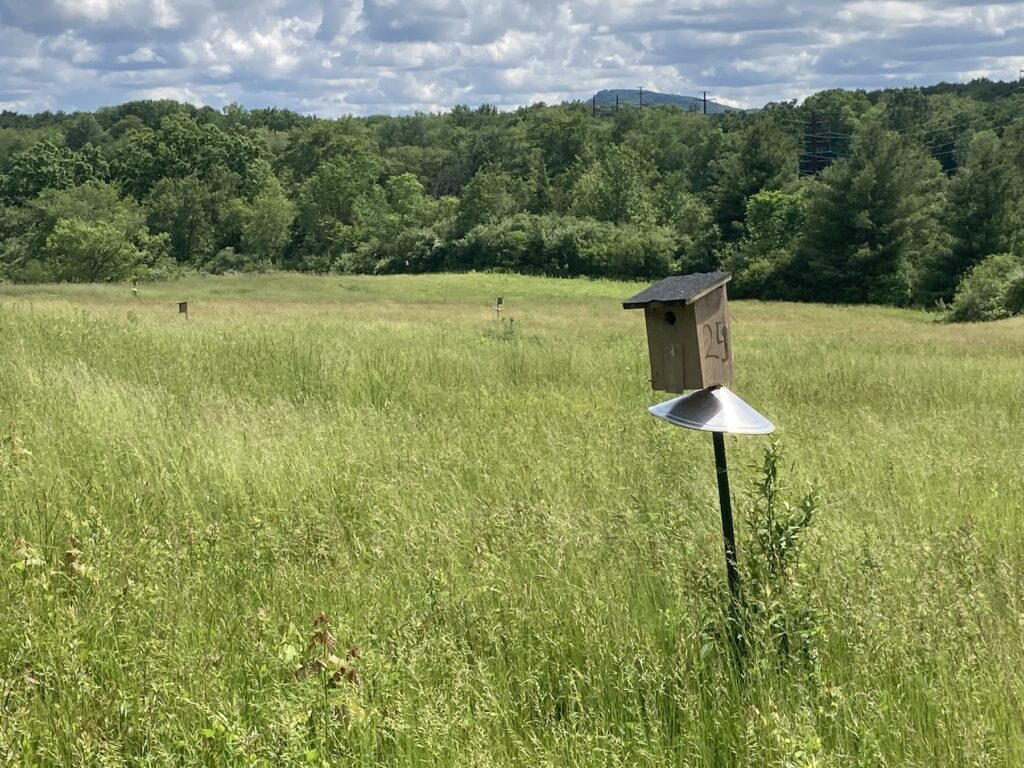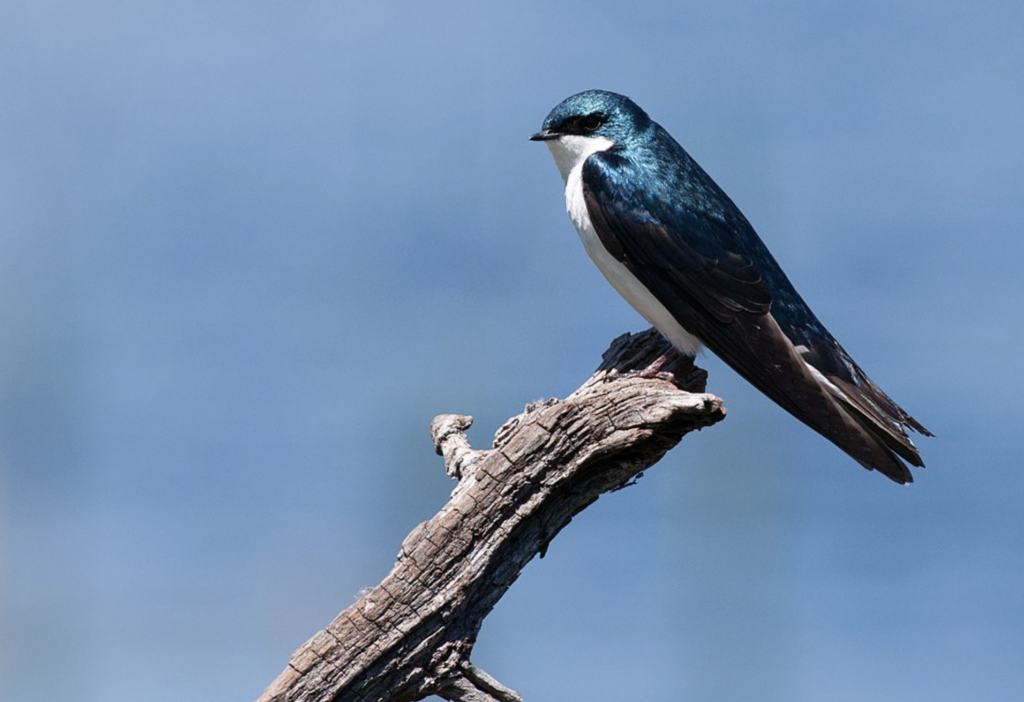Almanac: Idyll Interrupted

One of more than 100 bird boxes placed in the fields of the Amherst College Wildlife Sanctuary. Photo: Stephen Braun
No sooner had I written a column about birds mobbing other birds than I was mobbed by a bird myself. I was mountain biking along the trails mown through the wide grassy fields of the Amherst College Wildlife Sanctuary between the bike trail and the Fort River. It was late evening and golden sunlight bathed the verdant landscape, with big, billowy cumulus clouds rising over the Holyoke range like so many gigantic heads of cauliflower. Small birds were active over the fields, rising and swooping through the air, but I didn’t pay attention to them. I was too captivated by the beautiful Maxfield Parrish-esque quality of the scene.
When I stopped to admire the view, however, my attention was suddenly and vividly diverted to one of those birds, which zoomed directly at my head. It veered off a split second before it would have hit me, with a burst of high-pitched, scolding chatter.
What the heck??? The bird circled with the smooth precision of a WWII fighter jet, locked me in its sights, and came straight at me again. I ducked this time, recognizing my assailant as a swallow, although I couldn’t identify it, what with being distracted by self-preservation. Realizing that this kind of mobbing behavior was defensive, I looked around to see what I could possibly be threatening. Only then did I notice that I had stopped near one of the many wooden bird house boxes placed on posts all over the wide fields.
As my attacker was readying for yet another parry, I noticed another of the birds land and enter the house near me. Aha!
I picked up my bike to leave. “Sorry!” I said to my fierce little foe. “My bad! Didn’t mean to disturb you or your family!” I pedaled back the way I came, curious now about the identity of this fearless creature that had given me my first taste of what large birds might feel as they’re being antagonized by smaller ones.
I’ve see the bird boxes for years and always thought they were to provide nesting habitat for bluebirds, which at one time were endangered. It turns out that bluebirds can, and sometimes do, build nests in the boxes, but only because bluebirds prefer entrance holes exactly the same size as those preferred by the actual target of the bird box effort: tree swallows.

Since 2004, under the direction of Ethan Clotfelter, professor of biology and environmental studies at Amherst, roughly 120 nest boxes have been maintained to attract the tree swallows and provide easy access to the nests and young. Many research papers have been published based on the research conducted in the fields about how the swallows respond to environmental challenges such as insect parasites and changes in nest temperature.
I returned to the fields the next day with binoculars—being careful to keep my distance from the boxes this time. The magnified view revealed the splendor of these aerialists’ deep blue iridescent backs, which glitter and flash in sunlight as they twist and turn in their pursuit of flying insects. Like all swallows, tree swallows can open their mouths very wide in flight to catch their prey and, also, to drink water by skimming the surface of a pond or stream.
Tree swallows pair up to breed, with females doing most of the work to build the nest, but males may also mate outside the pair and attend separate nest sites. Though an individual swallow may have the same mate several years in a row, it is probably faithful to the site rather than the mate.
As I discovered, tree swallows will commonly swarm and dive-bomb predators, which include snakes, raccoons, black bears, feral cats, crows, and raptors of all sorts.
The swallows will be with us for months to come if you’re interested in observing these birds yourself. They are the first swallows to arrive from the south in the spring, and the last to leave in the fall. They have the unique ability to digest the waxy coatings of bayberries, which provides them with an additional food source in the fall and, thus, a survival advantage over other swallows.
In addition to the lovely, swallow-filled fields, the wildlife sanctuary includes a pond, wetlands, and forests of various types and maturity, with all trails open to the public (a map is available here). The usual cautions and courtesies apply: don’t mountain bike when trails are muddy, don’t disturb the boxes or any other research apparatus, and watch out for poison ivy, which is rampant in some of the open areas. The roughly 500 acres of sanctuary land was developed by Amherst College in 1933 and has been maintained and improved since then, which is incredibly fortunate since without this protection the land would undoubtedly have been developed by now.
Almanac is a regular Indy column of observations, musings, and occasional harangues related to the woods, waters, mountains, and skies of the Pioneer Valley. Please feel free to comment on posts and add your own experiences or observations.
